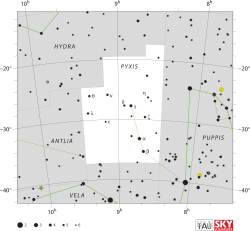Beta Pyxidis
| Beta Pyxidis (β) | |
 | |
| Observationsdata Epok: J2000.0 | |
|---|---|
| Stjärnbild | Kompassen |
| Rektascension | 08t 40m 06,14363s[1] |
| Deklination | -35° 18′ 30,0″[1] |
| Skenbar magnitud () | +3,954[2] |
| Stjärntyp | |
| Spektraltyp | G7Ib-II[3] |
| U–B | +0,646[2] |
| B–V | +0,935[2] |
| Astrometri | |
| Radialhastighet () | -13,4[4] km/s |
| Egenrörelse (µ) | RA: +9,84[1] mas/år Dek.: -20,80[1] mas/år |
| Parallax () | 7,84 ± 0,19[1] |
| Avstånd | 420 ± 10 lå (128 ± 3 pc) |
| Absolut magnitud () | -0,78[5] |
| Detaljer | |
| Radie | 28[6] R☉ |
| Luminositet | 478,58[7] L☉ |
| Temperatur | 5 590 ± 168[8] K |
| Metallicitet | -0,06 ± 0,13[8] dex |
| Vinkelhastighet | 11,8[9] km/s |
| Andra beteckningar | |
| β Pyxidis, P Pyx, Beta Pyx, CPD- 34 2846, FK5 2681, HD 74006, HIP 42515, HR 3438, SAO 199490, WDS J08401-3518A[3] | |
Beta Pyxidis (β Pyxidis, förkortat Beta Pyx, β Pyx) som är stjärnans Bayerbeteckning, är en dubbel stjärna belägen i den sydvästra delen av stjärnbilden Kompassen. Den har en skenbar magnitud på 3,95[2] och är synlig för blotta ögat där ljusföroreningar ej förekommer. Baserat på parallaxmätning inom Hipparcosuppdraget på ca 7,8[1] mas, beräknas den befinna sig på ett avstånd på ca 420 ljusår (ca 128 parsek) från solen.
Egenskaper[redigera | redigera wikitext]
Beta Pyxidis är en gul till vit ljusstark jättestjärna av spektralklass G7Ib-II[3]. Den har en radie som är ca 28[6] gånger större än solens och utsänder från dess fotosfär ca 480[7] gånger mera energi än solen vid en effektiv temperatur på ca 5 400[8] K.
Beta Pyxidis har en ovanligt stark rotation för en utvecklad stjärna av denna typ, med en projicerad rotationshastighet på 11,8 km/s. En möjlig förklaring är att den kan ha uppslukat en närliggande jätteplanet, som en het Jupiter.[9]
År 2010 ingick stjärnan i en undersökning av massiva superjättar, med lägre effektiv temperatur, i ett försök att upptäcka ett magnetfält. Den kan ha ett longitudinellt magnetfält med en styrka mindre än en Gauss.[10] Den hade 1943 en optisk följeslagare av magnitud 12,5, belägen med en vinkelseparation på 12,7 bågsekunder vid en positionsvinkel på 118°.[11]
Källor[redigera | redigera wikitext]
- Den här artikeln är helt eller delvis baserad på material från engelskspråkiga Wikipedia, tidigare version.
Referenser[redigera | redigera wikitext]
- ^ [a b c d e f] van Leeuwen, F. (November 2007). "Validation of the new Hipparcos reduction". Astronomy and Astrophysics. 474 (2): 653–664. arXiv:0708.1752 . Bibcode:2007A&A...474..653V. doi:10.1051/0004-6361:20078357.
- ^ [a b c d] Gutierrez-Moreno, Adelina; et al. (1966). "A System of photometric standards". 1. Publicaciones Universidad de Chile, Department de Astronomy: 1–17. Bibcode:1966PDAUC...1....1G.
- ^ [a b c] "bet Pyx -- Star in double system". SIMBAD. Centre de Données astronomiques de Strasbourg. Hämtad 2009-04-15.
- ^ Evans, D. S. (June 20–24, 1966). "The Revision of the General Catalogue of Radial Velocities". Proceedings from IAU Symposium no. 30, Determination of Radial Velocities and their Applications. University of Toronto: Dordrecht, D. Reidel Publishing Co. Bibcode:1967IAUS...30...57E.
- ^ Eggen, O. J. (1994). "Photometry of F-K type bright giants and supergiants. 3: The luminosity, reddening, and heavy element abundance of GK stars". The Astrophysical Journal. 107 (6): 2184–2210, 2205. Bibcode:1994AJ....107.2184E. doi:10.1086/117030.
- ^ [a b] Lang, Kenneth R. (2006), Astrophysical formulae, Astronomy and astrophysics library, 1 (3rd ed.), Birkhäuser, ISBN 3-540-29692-1. The radius (R*) is given by::
- ^ [a b] https://www.universeguide.com/star/betapyxidis. Hämtad 2018-04-26.
- ^ [a b c] Alves, S.; et al. (April 2015), "Determination of the spectroscopic stellar parameters for 257 field giant stars", Monthly Notices of the Royal Astronomical Society, 448 (3): 2749–2765, arXiv:1503.02556 , Bibcode:2015MNRAS.448.2749A, doi:10.1093/mnras/stv189.
- ^ [a b] Rodrigues da Silva, R.; et al. (March 2015). "On the Nature of Rapidly Rotating Single Evolved Stars". The Astrophysical Journal. 801 (1): 6. arXiv:1503.03447 . Bibcode:2015ApJ...801...54R. doi:10.1088/0004-637X/801/1/54. 54.
- ^ Grunhut, J. H.; et al. (November 2010), "Systematic detection of magnetic fields in massive, late-type supergiants", Monthly Notices of the Royal Astronomical Society, 408 (4): 2290–2297, arXiv:1006.5891 , Bibcode:2010MNRAS.408.2290G, doi:10.1111/j.1365-2966.2010.17275.x
- ^ Worley, C. E.; Douglas, G. G. (November 1997), "The Washington double star catalogue (WDS, 1996.0)", Astronomy & Astrophysics Supplement Series, 125: 523, Bibcode:1997A&AS..125..523W, doi:10.1051/aas:1997239
Externa länkar[redigera | redigera wikitext]
| |||||||||||||||||||






